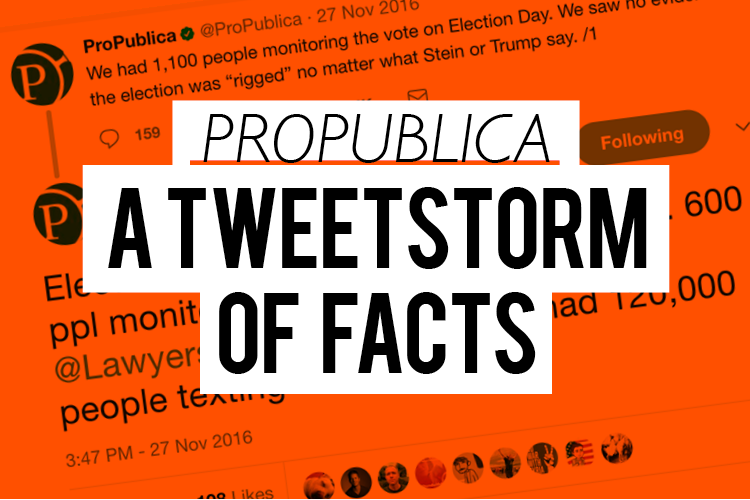
A tweetstorm of facts
Creator: ProPublica
Summary: An edited series of fast tweets designed to allow facts to combat misinformation in real time.
_____________________________________________
On Thanksgiving weekend 2016, President Trump’s Twitter activity spurred ProPublica to embark on a new form of explainer journalism for the non-profit — the tweetstorm.
Faced with a tweet from the president-elect saying he would have “won the popular vote if you deduct the millions of people who voted illegally,” ProPublica weighed how to combat the false claim — one that the news organization was uniquely positioned to disprove. ProPublica had just organized a massive project called Electionland, which tracked voter issues on Election Day using a team of more than 1,000 people across the country.
Given the holiday weekend, a traditional long story was deemed too complicated. “Actually what you want to do is respond in real time. What’s the vehicle for responding in real time?” says deputy managing editor Eric Umansky, recalling the discussion.“Let’s just do a tweetstorm.”
The ensuing 15-tweet thread went viral, drawing thousands of retweets and likes, and a new mission was born for ProPublica. Umansky and his self-described “no-bullshit” engagement team put measures in place to better use social media as a platform to tell stories rather than just promote the so-called “real story” on the website.
Now, a reporter writes a tweetstorm, then runs it by an editor and an in-house lawyer to get approval, a process that can take a few minutes but which has proven an essential safeguard after an early misstep in one piece of the voting tweetstorm.
ProPublica’s approach was further validated after Sean Spicer “blessedly” called ProPublica a “left-wing blog” in response to a story about the president changing his trust to enable him to take money from his businesses.
That thread had upwards of 24,000 retweets. ProPublica gained 100,000-plus new followers and donations rolled in.
One key to ProPublica’s tweetstorms is a conversational tone that doesn’t dip into opinion or bias, a style that Umansky said can be hard to pull off. “We encourage voice but not irresponsible voice,” he says. A news organization must trust its social team to toe this line since a top-heavy editing structure risks “losing the magic” of social.
Also, rather than using a solo siloed staffer who may not have as much journalism experience, ProPublica draws from a team of reporters and editors who rotate into the role for a week at a time, which Umansky says helps avoid the “Twitter hamster wheel” and keeps the team intellectually engaged.
Working with Umansky are engagement editor Terry Parris Jr., and reporters Adriana Gallardo and Ariana Tobin. Another reporter, Jessica Huseman, also pitches and writes tweetstorms, including this one on climate change and President Trump’s claims about the Paris Accord.
Umansky considers tweetstorms just as likely to offer information retention as a typical story. He notes that Chartbeat data show that readers don’t often read very far no matter how many thousands of words a regular story is.
“At the end of the day, we want to tell the truth and for that truth to resonate. I think this is just another vehicle for that.”
Technical details and modifications: Plenty of individual journalists use standalone tweetstorms to dispel misinformation. (Follow the New York Times’ Rukmini Callimachi on terrorism and Politico’s Michael Grunwald on policy and the environment.) But ProPublica is one of the few that uses its main Twitter handle this way. Umansky notes that the nonprofit has the benefit of not monetizing page views on its site, so telling some stories solely on social doesn’t hurt its bottom line. Still, other news organization can use tweetstorm summaries to link to longer stories; or use the platform to tell stories that advance its brand, building its subscriber base.
Share with your network
Improving accountability reporting
You also might be interested in:
As research continues to inform this slice of the news industry, we’ll continue learning, too. Who gets to be called a journalist in 2025 and beyond? What is the future of trustworthy information, especially considering the access to and trust for online content creators? How might journalism adapt to the rise, or co-opt the styles, of news influencers?
What if we started looking at our output as a product, not a service? Too often, we think "product" means a fancy app or a new website. But product isn’t about tech. It’s about intention.
When we began asking what kind of stories still mattered to Baca County, we realized many of them weren’t “breaking news” but generational memory. And the paper was the last remaining platform that treated those memories with care and context.





